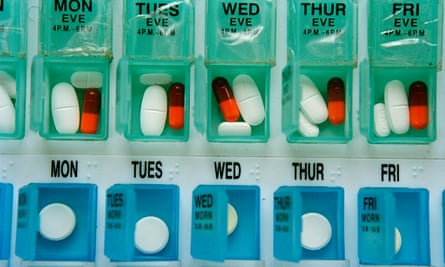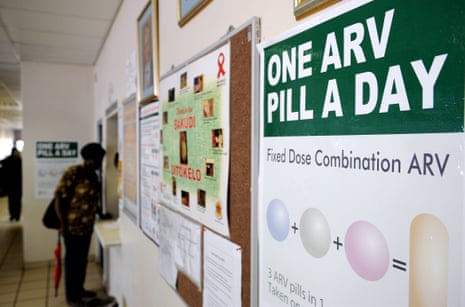South Africa has begun rolling out a state-of-the-art antiretroviral drug in a “game-changing” bid to drastically reduce the number of people living with HIV.
The distribution of the new three-in-one pill, timed to coincide with World Aids Day on Sunday, is eventually expected to treat the 7.7 million South Africans who have HIV, accounting for 20% of the global prevalence of the disease.
Described by South Africa’s health minister, Zweli Mkhize, as “the fastest way to reduce HIV viral load”, the fixed-dose combination has fewer side effects and is easier to take than other formulations. One of the main ingredients, dolutegravir, is already the drug of choice in higher income countries.
“The introduction of this new regimen, known as TLD, is a major milestone and game-changer for South Africa, which has the highest burden of HIV of any country in the world,” said Robert Matiru of the global health development organisation Unitaid, which financed the drug’s development.
“The government has the very ambitious plan of switching the 4.8 million South Africans who are currently on the older regimen of HIV treatment on to this new regimen by 2021, in addition to getting the remaining [roughly] 3 million people who are not currently on HIV treatment on to this regimen by then as well. It’s a massive undertaking to put in place, and is a really welcome move for the people of South Africa.”
Matiru said savings created by transferring those already receiving antiretrovirals (ARVs) to the new, cheaper regimen could allow up to 5 million more people to receive treatment.
South Africa accounts for more than 10% of all HIV-related deaths and 15% of new infections globally, according to Unitaid. Only 62% of those living with HIV in South Africa are currently on treatment and fewer than 50% of young South Africans who come forward for HIV care successfully initiate ARV therapy.
The country’s introduction of the TLD regimen is likely to have a far-reaching impact on HIV incidence in South Africa as well as the global response, said Dr Michelle Moorhouse, of Ezintsha, Wits Reproductive Health and HIV Institute in Johannesburg.

“We are likely to see a dramatic impact on the rate of new infections,” said Moorhouse. “In fact, moving to DTG could halve the number of new infections in South Africa between now and 2038, especially if we get people on treatment more quickly. And as HIV in South Africa accounts for about 20% of infections globally, this impacts the global infection rate.”
Just 24.5 million of the estimated 37.9 million people living worldwide with HIV are currently on ARVs, said Matiru. “Once South Africa scales up its response to include the 3 million who aren’t currently on treatment, that will help close the global gap.”
Although global HIV infections among adults have dropped by 17% since 2010, the decline is far short of the 60% drop required in 2018 to meet global HIV prevention targets, according to the Global HIV Prevention Coalition. Just 28 countries account for 75% of all new HIV infections globally, according to a report published by the coalition in October – and some of them, including Nigeria and Pakistan, have shown a troubling increase in infections.
A dozen countries have reduced new adult HIV infections by 26% or more since 2010, including South Africa (39%), the Democratic Republic of the Congo (37%), Uganda (36%), and Zimbabwe (28%).
However, in Nigeria, new adult HIV infections increased by 8% from 2010, while in Pakistan new adult HIV infections rose by a staggering 56%.
Tabitha Ha, advocacy manager at StopAids, said: “Despite progress over the past few decades, HIV infection rates are still increasing at alarming rates in places such as Pakistan and South Sudan, and in regions such as eastern Europe.
“This means we are off track in meeting our global goal target to end Aids by 2030. While some countries are stepping up the fight, others are lagging way behind.
“Global prevention efforts need to be ramped up urgently in order to get us back on track and offer us the opportunity to turn the tide. We must collectively increase our financial investment in prevention tools, break down stigma and discrimination, as well as remove the legal and structural barriers that prevent people most likely to be affected with HIV from accessing healthcare.”
